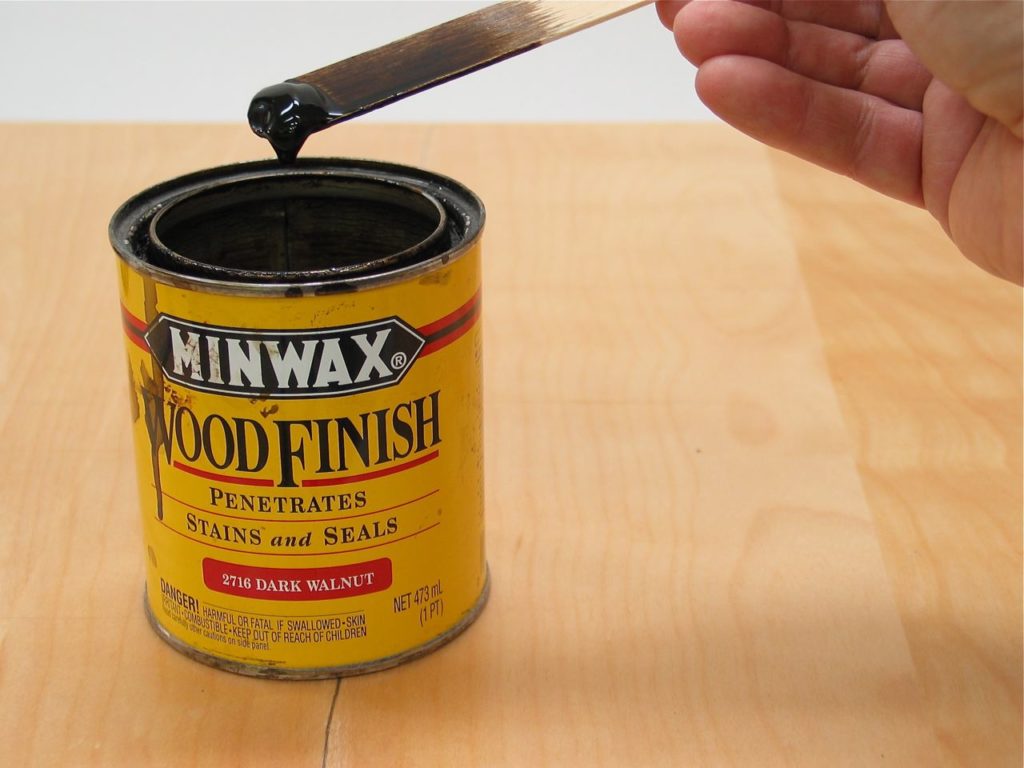We may receive a commission when you use our affiliate links. However, this does not impact our recommendations.

This stain clearly contains both pigment and dye.
A woodworker friend asked me what type colorants, pigment or dye, were used in Minwax stains. He had called Minwax and was told that they use only pigment, but this didn’t match with my friend’s experience. I found it not surprising at all that the Minwax tech didn’t understand his company’s products.
It’s easy to tell the colorant used in a stain. Let the stain sit on a shelf for a couple of weeks so any pigment in it has time to settle to the bottom. Then stick a light colored stirring stick about halfway down in the can. If the stain colors the stick, it contains dye because dye is dissolved in the solvent; it doesn’t settle.
Then put the stirring stick all the way down to the bottom of the can and see if you can pull up some solid colorant. If you can, the stain contains pigment because pigment isn’t dissolved; it is suspended in the liquid, so it settles.
You can use different stirring sticks for each test or just one. You can do this test with all brands of stain.
My experience with Minwax stains is that cherry contains only pigment. Golden oak and puritan pine contain only dye. All the rest I’ve tested contain both pigment and dye.
I have no idea why it’s this way. These stains were formulated many decades ago. I can’t imagine that anyone at Minwax today, after the number of times the company has been sold, knows why. But does it matter?
Not really. The key that makes these stains work differently from pure dye stains that are dissolved in just a solvent is that stains in cans contain a binder. In the case of these Minwax stains the binder is oil. In the case with General Finish’s “dye” stains, the binder is acrylic resin. It’s the binder that makes these stains work differently from what we call dye stains.
The only characteristic you need to be aware of, and maybe take into account, with the Minwax stains is that dye fades fairly rapidly in sunlight. Pigment is much more resistant to fading. So the dye in most of Minwax’s stains could fade if the stained object is placed in sunlight, even indoors through glass.
– Bob Flexner
Here are some supplies and tools we find essential in our everyday work around the shop. We may receive a commission from sales referred by our links; however, we have carefully selected these products for their usefulness and quality.










Bob, thanks for posting this. It explains why I’m tearing my hair out. I stained 3 small birch pieces with Minwax dark walnut and all 3 turned blotchy. I stripped them with Citristrip, which got out the surface color, but the deep color – with all the %@#&$@ blotches – is still there, and I can’t figure out how to get the rest of the color out. I’ve had 3 different recommendations for removing the deep color – muriatic acid, wood bleach (lye & peroxide), and lacquer thinner. I’m afraid to make the situation any worse.
Hello Mr. Flexner,
I am new to refinishing and have been reading and learning from your books and DVD. I have a question about water marks not a comment about this blog post.
I wanted to get rid of a water mark from a glass on a teak bar cart that I am pretty sure finished with just Danish Oil. While reading one of your books I mis-understood the section on removing white water stains and used petroleum jelly on the water mark and left it on overnight. I then read the next section in the book on removing water marks from “oil finishes” (the section I should have read first!) which said the surface simply needs to be sanded and re-oiled several times. I then did this (with Danish Oil and 600 grit wet/dry sandpaper). The white water mark is fading but there is a darkish circle which I am guessing is oil residue from the petroleum jelly and I can still see the a ring on the cart at certain angles. It almost looks like the Danish oil I applied isn’t penetrating the wood properly, because of the petroleum jelly I suspect. Is there a way to remove the petroleum jelly if this is indeed the case? Can I dissolve it with mineral spirits and then sand and apply the oil again?
Thanks very much!
This helped me out quite a bit. I Used Jacobean to stain an exterior glulam beam and I couldn’t understand why it has been fading so quickly. I will try the other product mentioned in this article.